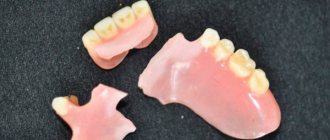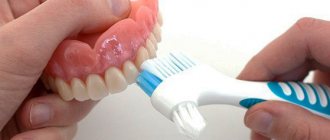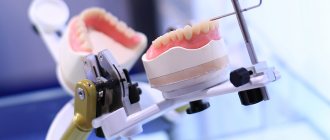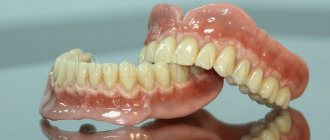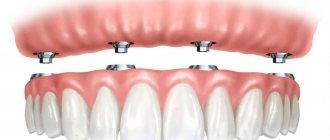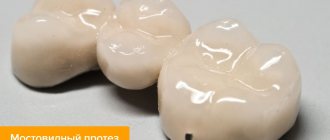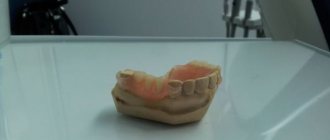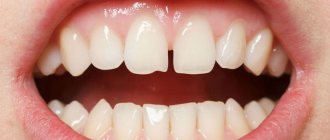Completely removable dentures are used for prosthetics of jaws that are completely devoid of teeth (in the case of edentia). The prosthesis is held on the jaw due to its tight fit to the tissues of the prosthetic bed. If we are talking about a prosthesis for the upper jaw, then high-quality fixation can be achieved through a special valve that creates negative pressure, that is, in essence, the prosthesis is held in place by vacuum. Traditionally, dentures for the lower jaw are very uncomfortable, this is due to poor conditions for their reliable fixation. Specially developed adhesive pastes and creams can help keep the prosthesis in place; they significantly improve the retention (fit) of the structure. Often, such dentures are made of acrylic plastic, with the help of special dyes, it is given the color and shade of the patient’s gums so that it does not stand out against the background of the oral cavity, and artificial teeth are mounted into it, which exactly imitate a person’s normal bite.
The process of getting used to dentures (full or partial) is often long and difficult
Thanks to such products, patients can enjoy life again, eat whatever they want (and even what they could not afford before), since chewing function is completely restored. Without the use of this type of prosthesis, you can forget about normal trips to catering establishments or family feasts, since such a person will not be able to afford anything other than yogurt or puree.
But the question arises - how to get used to dentures ? The process of getting used to removable dentures is very long and often difficult. Such prosthetics cannot be called a complete procedure, since the oral mucosa is constantly irritated, and the patient himself experiences discomfort.
What problems may arise after installing a denture?
Adaptation to a removable denture begins almost immediately after installation is completed in the dentist's office. And, according to statistics, almost every patient experiences certain difficulties that are associated with the adaptation period. Here are some of them:
- Vomiting reflex . Constant vomiting is a completely normal reaction of the body to a foreign object in the oral cavity, so there is no need to worry too much about this. But there is a category of people who take the longest to get used to dentures, or who don’t get used to them at all. The installation of products that stick to the sky is contraindicated for them. This must be taken into account when choosing a prosthetic method. Often, this problem goes away on its own. But for patients with hypersensitivity, it is better to abandon such structures altogether.
- Profuse salivation . The human body perceives the prosthesis as food, as a result of which the brain sends signals that then activate the corresponding functions, namely the secretion of saliva and gastric juice.
- Unpleasant sensations while eating . First of all, this problem affects the owners of removable dentures; the load is unevenly distributed across the jaw, in contrast to the natural chewing of food with real teeth. It takes a long time to get used to this.
- Perception of taste . You may partially lose your sense of taste, since not only the tongue (as many believe), but also the rest of the oral cavity is involved in its perception. The patient may stop feeling spicy, salty, hot or sweet foods; this process occurs differently for everyone.
- Distortion of speech . The prosthesis and its protruding parts can interfere with the tongue; a person with an installed prosthesis has difficulty pronouncing words. But after some time (about a week), diction returns to normal.
Why do you need to get a dental crown?
Dental crowns are the most popular method of prosthetics for various defects, trauma or other destruction of the dentition. Let's consider the features of different options for dental crowns, the preparatory process and the installation of this product itself, as well as possible complications and some nuances of removing dentures.
People who have lost teeth, especially in a particularly visible part, do not ask: “Why do you need to get a dental crown?” However, there are times when it becomes necessary to install a crown, even if all the teeth are present:
- Natural human teeth are subject to defects in color or shape and do not look very attractive. Dental crowns can correct these problems while adding aesthetics to your smile.
- The natural dental crown is damaged as a result of significant carious disease or injury, but the root is in place and has the opportunity to play a supporting role. In this option, you can place a crown directly on the tooth root with a stump (if a sufficient amount of natural tissue has been preserved). Or prosthetics require the use of inlays or pins, which can create reliable stability of the entire structure.
- When teeth are affected by periodontal disease, there is sometimes a risk of increased tooth loosening. Moreover, it is possible to install temporary crowns that will hold the teeth in place until complete recovery.
- All teeth are preserved, but pathological destruction of the enamel occurs. In this case, a crown is necessary to protect the dental tissues from adverse factors.
Useful tips for those who have recently installed a prosthesis
Literally from the first days of using a prosthesis, many patients complain of pain, as well as abrasions and scratches in the oral cavity. In fact, mechanical damage should not occur, since this point was thought out at the product design stage. Perhaps you are simply wearing it incorrectly. If the problem does not resolve itself, you need to contact your dentist for further adjustments to the prosthesis.
The tips given below will not completely relieve you of difficulties during the adaptation period, but they will significantly reduce the level of negative impact and will help you get used to the prosthesis faster.
The process of chewing food causes pain, so in the first few weeks it is better to protect yourself from eating solid and tough foods: meat, nuts, cookies, etc. If even soft food is painful to chew, then at first you can cut it into small pieces. Trust your feelings, and when the pain begins to subside, gradually move on to your usual, normal diet.
Under no circumstances should you reduce the number of meals. Most patients, due to a strong fear of getting damage to the oral cavity (and they take a very long time to heal), switch to liquid foods and yoghurts. But this is not the right solution, since in order to get used to the prosthesis, a constant chewing load is needed.
Foods such as pears, apples and citrus fruits should be cut into small pieces and chewed slowly, with great effort. This allows you to reduce the degree of damage to the mucous membrane, and also gives the body all the necessary vitamins.
If you have a dry mouth or increased salivation, it is recommended to drink plenty of liquid in small sips throughout the day.
If you feel slight numbness, you can do a light massage of the gums, this will improve blood circulation and the numbness will go away in just a few minutes. In this case, you need to remove the prosthesis.
Decoctions of herbs such as sage and chamomile will help strengthen your gums and prevent irritation. It is advisable to carry out the procedure three times a day. The decoction should never be hot; liquid at room temperature is the best option.
Frequently asked questions from readers
How to put on dentures correctly?
The doctor will tell you about the technique of installing dentures in the mouth, he will also ask you to repeat the steps and, if necessary, make adjustments. In the future you will have to do this yourself. To make the task easier, follow the recommendations:
- Training in front of a mirror will help you develop the skill.
- After installation, try opening and closing your mouth several times, moving your jaws to the right and left.
- Do not remove the product at night, this will speed up the adaptation process.
How to quickly get used to dentures?
Here is a detailed article on this topic
The speed of adaptation largely depends on how responsibly the patient treats the adaptation process. Several recommendations will shorten and facilitate the adaptation period:
- Give preference to soft foods so that the mucous membrane adapts to chewing loads.
- Massage your gums. It normalizes blood circulation and reduces pain. To do this, place your index finger on the outside of the gum and your thumb on the inside. Gently rub your gums, pressing lightly on them. The procedure, which lasts 10 minutes, must be repeated several times a day.
- Do preventive rinses with sage or chamomile solutions. They will help prevent inflammation and disinfect injured tissue.
- Learn breathing techniques through your nose to combat your gag reflex.
- For the first 7-10 days, leave the structure in your mouth while you sleep.
- Drink more water to help relieve dry mouth.
For the first time, practice putting on your prosthesis in front of a mirror.
Usually it takes 1-3 months for complete adaptation, but in some cases this period can last up to a year.
Storage rules
Previously, rubber was used as the main material for the manufacture of prostheses. It cracked in the air, so the structures were stored exclusively in a glass of water. Now that more modern materials are used, there are no such strict requirements. However, doctors recommend storing products in a humid environment - water or a special disinfectant solution. The rules are simple:
- The solution should not contain chlorine (chlorine is especially harmful for metal parts).
- Water temperature is room temperature.
- When lowered into hot water, the product becomes deformed.
Most doctors agree that modern models do not need to be taken out at night. It is enough to clean them thoroughly before going to bed and reinstall them in the oral cavity.
Use a special box to store the prosthesis
Individual intolerance to dentures
Intolerance is indicated when the following symptoms appear:
- burning or itching of the mucous membrane;
- pain, local or deep;
- appearance of foreign tastes (metal, plastic);
- the occurrence of erythremas and ulcers.
The most common causes of intolerance:
- allergic reactions;
- toxicity of the materials used;
- mechanical irritations;
- general immune diseases;
- psychological factors.
Most often, in such cases, it is necessary to manufacture a new structure using materials that do not cause such reactions. But the doctor can send the patient for a consultation with specialized specialists - for example, a psychotherapist or an immunologist.
Purchase special brushes, pastes, and disinfectant solutions for prosthesis care.
Rules of care
Hygiene is one of the main conditions for quickly getting used to dentures. Care involves following several rules:
- After each meal, the structure must be rinsed. Those who wear removable dentures should remove them and wash them under running water.
- In the morning and evening, clean the products with a soft brush and paste that does not contain abrasive substances.
- Orthopedic systems require additional disinfection. For this, special products are used, usually available in the form of tablets, soluble in water. The prosthesis is placed in this solution for 15 minutes, the procedure is carried out 1-2 times a week.
Is it possible to whiten dentures?
Orthopedic systems tend to darken over time, especially if they are made of acrylic. Even after thorough polishing, it remains rough; a coating appears on the surface, easily absorbing any dyes. There are several methods of whitening:
- Mechanical cleaning with special brushes designed for dentures, which are sold in pharmacies. It is not recommended to use abrasive bleaching pastes: the particles they contain will damage the surface.
- Ultrasonic cleaning in a clinic is a prerequisite for proper product care. It must be carried out at least once a year.
- The use of special solutions, for the preparation of which soluble tablets are produced. They work through an antiseptic effect, disinfecting the surface, but do not remove stubborn plaque.
Should I rent it at night?
At night, orthopedic structures can be removed and stored in a humid environment to avoid drying out. However, during the first week you should sleep with them to speed up the addiction. At the same time, it is important not to forget that before going to bed and after waking up, the products must be removed and thoroughly cleaned.
You should not endure prolonged discomfort or acute pain. As a rule, they signal that the structure was manufactured and installed with violations, without taking into account some individual characteristics. In this case, only an orthopedist can help, who will make the necessary adjustments.
Accelerate the process of getting used to the prosthesis
- Rinse your mouth with a salt solution;
- Take the process of cleaning your denture seriously;
- Try sucking on lollipops, this process calms you down and distracts you from having a foreign object in your mouth;
- To improve your diction, say tongue twisters, read aloud, and speak more often. It’s also worth trying to pronounce words louder. Often, normal speech is restored within a few weeks;
- For a more reliable fixation of the prosthesis in the oral cavity, it is best to use special gels and ointments; they not only allow you to securely fix the product in the mouth, but also prevent the appearance of abrasion wounds and other mechanical damage to the oral cavity.
- It is necessary to completely exclude various sticky foods from the diet, and not only for the period of getting used to the prosthesis. These can be candies, various chocolate bars with nougat, toffees, etc.), they can not only cause discomfort during chewing, but also damage the structure.
What to do if the addiction is seriously delayed?
If, over a fairly long period of time, you cannot get used to the prosthesis (that is, to a foreign body in the mouth), then there may be several logical explanations for this problem:
- Jaw atrophy;
- Individual characteristics of the jaw structure of a particular patient;
- Poor fixation of the structure;
The most difficult thing to get used to is the so-called clasp structures, which are based on fastenings made of metal. In addition to mechanical effects, exposed metal parts can also have chemical effects, reacting with the acidic environment of the oral cavity. It is simply impossible to correct such a product on your own, as it is easily damaged. Therefore, if you have the feeling that such a design is rather poorly and unreliably fixed in your mouth, it is better to go to a specialist. If the mobility of the prosthesis inside the oral cavity is due to jaw atrophy, a special ointment for additional fixation can help you.
Terms of adaptation
For some, the feeling of discomfort passes quite quickly; for others, the adaptation process is inevitably associated with prolonged physical suffering.
Talking about exact dates is quite problematic, because quite a few factors play a role here. For example, the condition of the patient’s gums at the time of installation of the prosthesis. Severely damaged gums will begin to actively rub against the surface of the product, this will cause even greater irritation. In this case, the adaptation process will drag on for several months. The period of adaptation increases significantly when installing clasp dentures; this type of construction has many metal parts that easily damage the soft tissues of the oral cavity.
Psychological state is an important factor in the process of getting used to dentures. A person who experiences stress, is constantly nervous and tries to remove the prosthesis at the first opportunity, himself prolongs the adaptation period, and quite significantly.
If we talk about averages, then for most patients the adaptation period takes approximately two (2) weeks . The reasons listed above can guarantee to increase the period of adaptation to several months.
Preparing to install a crown
The procedure for preparing for the installation of a dental crown has a number of stages:
- Determination of the condition of the dental cavity and the clinical picture of a person. At this stage, the scope of the upcoming work is determined, the type of prosthesis is discussed and a treatment regimen is developed.
- If required, treatment of caries, periodontal disease, and inflammatory gum diseases is performed. On supporting teeth, old fillings are certainly replaced with new ones.
- When it is planned to install metal-ceramics, then, as a rule, tooth depulpation is performed to avoid inflammatory lesions.
- Tooth preparation is the removal of hardened tissues of varying thickness using special instruments. For metal dentures, it is necessary to remove 0.30 mm of dentin and enamel, and during the installation of metal-ceramics, the layer for removal can reach up to 1.9 mm. In addition, for a more durable attachment of the prosthesis, preparation of the teeth with a large indentation is required.
- Then, when the teeth are prepared and cured, impressions are made using a special paste, based on which dentures are made in a technical dental laboratory and on an individual basis.
- When the crown is made, a series of fittings are performed, where the accuracy of the prosthesis, its ease of placement and consistency in color and texture with respect to other teeth are determined. Often the finished prosthesis is fixed with cement temporarily. This is required for the person to fully ensure that the crown is comfortable and works correctly while chewing.
Caring for a removable denture
Proper care of the prosthesis is the key to the fastest possible adaptation. For those people who have previously carefully cared for their oral cavity and teeth, the process of caring for a denture will not become something scary and overly intrusive. You just need to learn a few simple rules:
- Rinse your mouth after every meal. It would also be a good idea to rinse the structure itself. Simply remove it from your mouth and rinse thoroughly under running water;
- Every morning, the denture must be cleaned with a brush and a special paste. Each type of prosthesis has its own accessories, which are selected separately. During the cleaning process, special attention should be paid to the inside of the prosthesis, this is where a huge number of different microorganisms accumulate, and food particles also become clogged. Otherwise, they can cause severe gum inflammation.
- Additional disinfection is still necessary. To carry it out, you will need to purchase some additional funds. In most cases, these are ointments or effervescent tablets, into the solution of which the prosthesis is dipped.
Some products for the care of dentures
Read about dental prosthetics in St. Petersburg in the article.
Moscow metro station Zvezdnaya, Danube Avenue, 23
Fit and apply the prosthesis.
- He carefully examines the prosthesis from all sides. Looks for sharp edges, protrusions, roughness on the inside of the prosthesis (The inside is the side that lies on the mucous membrane. The outside faces into the oral cavity). If flaws are found, the doctor immediately cuts them off with a cutter (Plastic is always processed with a cutter).
The doctor looks at the quality of the prosthesis. Is there any porosity (gas, granular, compression porosity, remember?). Is it well polished? Are your teeth aligned correctly?
- When the doctor is sure that everything is in order, he disinfects the prosthesis. And puts it on the patient’s jaw.
- The prosthesis should be easy to put on. In the upper jaw, it may be hampered by excessively large maxillary cusps. On the lower side there are undercuts in the retromalar area, on the lingual side. Then the doctor grinds off the base on this side. First on one side (left or right). If it doesn't help, then do both.
Grind off where number 3 is - When the doctor places the prosthesis on the jaw, he checks how well it holds. The doctor presses his finger on the front and side teeth. The prosthesis should not come off. The doctor checks the fixation of the back of the prosthesis by pressing his finger on the front teeth, pushing them towards the lips. The front part - pulling the incisors down or up - depends on the jaw. The stability of the prosthesis is checked in motion. No, the patient is not forced to run. Just move the lower jaw in different directions.
- The practitioner checks for balanced occlusion. He must correct what the technician was not able to fully create. Using occlusal paper (carbon paper), the doctor checks uniform interdental contacts. If they are not there, the doctor selectively grinds the teeth with a small milling cutter, trying to preserve the anatomical shape of the teeth. Until you achieve perfect occlusion.
- The doctor checks the boundaries of the prosthesis using Herbst tests (They were described in the article about taking impressions). The point is that with certain movements, the necessary muscles at the border of the prosthesis tense. And if something is wrong, the prosthesis will be reset. Although it holds up well in a relaxed mouth.
When checking, the doctor may find errors that he had not noticed before. Either he was a fool, or the technician made a mistake, who will figure it out now. In any case, we looked at some errors here. And we don’t want to repeat them. Anyone interested will read it. There were only three types of errors left that were not considered. This is a shortening of the borders of the prosthesis and shortening on the side of line A. And balancing.


